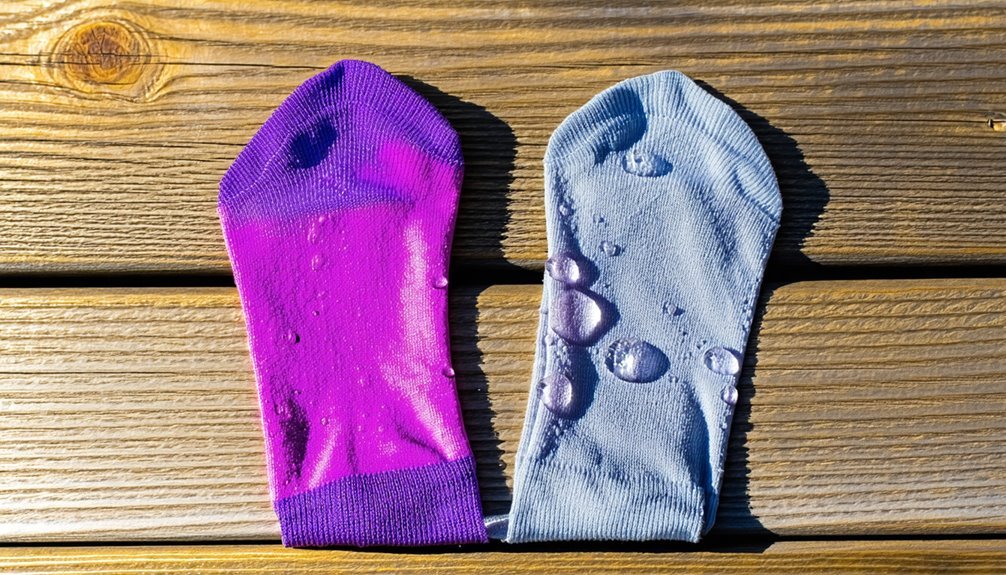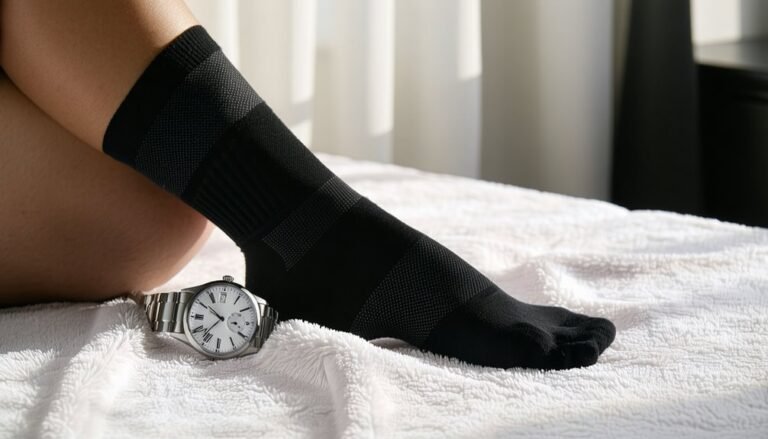Polyester Vs Nylon Socks
In the polyester vs nylon socks debate, both offer distinct advantages. Polyester is hydrophobic, keeping your feet dry by repelling moisture. It offers durability with vibrant color retention, suitable for colder environments. Nylon boasts superior elasticity and abrasion resistance, providing flexibility, breathability, and comfort, ideal for high-intensity activities and warmer climates. While polyester is budget-friendly, nylon guarantees a snug fit. Considering environmental impacts and specific use cases reveals even more intriguing insights.
Understanding Polyester and Nylon Materials

When delving into the composition of polyester and nylon, it's important to understand their fundamental differences. Polyester characteristics include hydrophobicity, meaning it repels moisture, which makes it quick-drying and suitable for maintaining dryness. Its synthetic fibers are strong yet lightweight, offering resilience without compromising comfort. Nylon characteristics, on the other hand, include a higher elasticity and abrasion resistance, providing flexibility and strength. Nylon is slightly more hydrophilic than polyester, allowing for better moisture absorption, enhancing comfort for extended wear.
Both materials are engineered for durability but differ in thermal properties; polyester retains heat better, while nylon is more breathable. When considering safety, polyester's resistance to mold and mildew is significant, whereas nylon's smooth texture reduces skin irritation, vital for sensitive skin.
Durability and Longevity
When evaluating the durability and longevity of polyester and nylon socks, you'll consider material wear and tear, fiber strength, and factors influencing sock lifespan. Polyester fibers exhibit superior resistance to abrasion, making them less prone to surface wear, while nylon's exceptional tensile strength offers enhanced resistance to mechanical stress. To optimize sock longevity, it's essential to evaluate how each material responds to environmental conditions and repeated use.
Material Wear and Tear
Durability is an essential factor when evaluating the longevity of synthetic fibers like polyester and nylon in sock manufacturing. When examining material wear and tear, you'll find that polyester generally offers superior wear resistance. This means it's less likely to degrade over time due to friction, making it ideal for environments where abrasion resistance is important. Nylon, on the other hand, possesses considerable abrasion resistance but may not match polyester's wear resistance when exposed to prolonged friction. However, nylon's strength lies in its flexibility, which can help prevent fiber breakage under stress. For those prioritizing safety and longevity, understanding these material properties guarantees you're choosing socks that withstand daily wear, reducing the risk of sudden failure in high-stress situations.
Fiber Strength Comparison
Although both polyester and nylon are prominent in sock manufacturing, their fiber strength varies considerably, impacting durability and longevity. When evaluating fiber strength, nylon exhibits superior tensile strength compared to polyester. This means nylon can withstand greater tension before breaking, offering enhanced robustness. In technical terms, nylon's higher tensile strength provides better resistance to physical stress and mechanical wear. This property is vital for maintaining the structural integrity of socks, especially under rigorous conditions.
Polyester, while less robust in tensile comparison, offers its own advantages in abrasion resistance. However, if your priority is safety and prolonged wear without compromise, nylon's superior fiber strength makes it a more reliable choice. Understanding these material properties helps guarantee that your socks maintain their form and function over time.
Sock Lifespan Factors
Understanding sock lifespan factors necessitates a focus on durability and longevity, which are greatly influenced by the material's inherent properties. Polyester and nylon exhibit distinct characteristics impacting their resilience. Polyester's hydrophobic nature offers resistance to moisture, reducing the occurrence of fabric degradation, consequently prolonging sock lifespan. Nylon, known for its tensile strength, provides superior elasticity, allowing it to withstand higher stress during sock usage.
Both materials require specific washing methods to maintain integrity. Polyester benefits from cooler water temperatures, minimizing fiber damage. Nylon, conversely, should be washed with care to prevent weakening of its fibers. Proper adherence to these guidelines guarantees your socks remain intact, providing comfort and safety. Prioritizing these practices in sock care enhances both durability and longevity, thereby guaranteeing peak performance.
Comfort and Texture
When considering the comfort of polyester versus nylon socks, you'll find these materials exhibit distinct characteristics in softness and stretchability. Polyester is often engineered for a softer hand feel, while nylon provides superior elasticity, contributing to a snug fit. Additionally, both materials are designed with moisture-wicking properties, yet the hydrophobic nature of polyester generally offers enhanced moisture management, keeping your feet drier during wear.
Softness and Stretchability
While evaluating the comfort and texture of socks, the material's softness and stretchability are critical factors to take into account. In a softness comparison, polyester and nylon both offer unique tactile experiences. Polyester is typically softer, providing a plush feel against the skin, which is essential for prolonged wear and minimizing friction. Nylon, however, is known for its resilience and slightly firmer texture, which can contribute to a snug fit.
In terms of stretchability analysis, nylon excels with its superior elasticity, guaranteeing a secure fit that adapts to your foot's movements. Polyester also stretches but may not recover as effectively, potentially leading to a looser fit over time. When prioritizing comfort and safety, understanding these material properties guarantees you choose the right socks for your needs.
Moisture-Wicking Properties
Moisture-wicking properties in socks are essential for maintaining foot comfort and hygiene, particularly during extended wear or physical activity. Polyester and nylon, both synthetic fibers, exhibit distinct characteristics in moisture management. Polyester excels in moisture absorption due to its hydrophobic nature, effectively pulling sweat away from the skin. This process enhances sweat evaporation, keeping your feet dry and reducing the risk of bacterial growth. Nylon, while less efficient in moisture absorption, compensates with high durability and elasticity, offering a snug fit that minimizes friction and blister formation. For ideal safety and comfort, consider your activity level and environmental conditions when selecting between polyester's superior moisture control or nylon's robust structure. Balancing these factors guarantees enhanced foot health and overall satisfaction.
Moisture Management and Breathability

Although both polyester and nylon socks are popular choices for their durability and comfort, their effectiveness in moisture management and breathability varies due to distinct material properties. Polyester, with its hydrophobic nature, excels in moisture retention reduction, effectively channeling sweat away from the skin. This results in enhanced dryness and reduced risk of blisters, essential for safety during rigorous activities. Nylon, while also offering moisture management, may exhibit slightly higher moisture retention under extensive breathability tests. However, its superior tensile strength makes it a robust choice for physical activities where durability is critical. Breathability in both materials is significant, as it directly impacts thermal comfort and skin health. When selecting socks, weigh these factors to guarantee ideal moisture control and safety.
Elasticity and Fit
When evaluating socks for ideal elasticity and fit, understanding the material properties of polyester and nylon becomes crucial. Polyester offers moderate elasticity, allowing for a snug fit that adapts well to various foot shapes. However, nylon excels in elasticity testing, providing superior stretchability and recovery, which guarantees consistent fit variations across different sizes. This enhanced elasticity in nylon contributes to a tighter fit, reducing the risk of slippage during movement, thereby enhancing safety.
Additionally, nylon's structure allows it to maintain its stretch over time, minimizing wear-induced slack. Polyester, while durable, may experience a gradual loss of elasticity, affecting long-term fit. For individuals prioritizing safety and comfort, nylon's superior elastic properties make it a preferable choice, guaranteeing reliable fit and consistent performance.
Color Retention and Aesthetics
While evaluating the aesthetics and color retention of socks, it is essential to explore the material properties of polyester and nylon. Polyester excels in maintaining vibrant hues due to its inherent resistance to color fading. This makes it an ideal choice for those seeking long-lasting, bold aesthetics. Nylon, although durable, can exhibit slight color fading over time, especially with exposure to sunlight. Understanding these properties guarantees you select a material that aligns with your aesthetic and safety preferences.
Here's a comparison:
| Material | Color Retention |
|---|---|
| Polyester | High, vibrant hues |
| Nylon | Moderate, some fading |
| Safety Aspect | Material Preference |
| UV Exposure | Polyester |
| Durability | Nylon |
Choosing wisely based on these factors enhances the aesthetic longevity and safety of your socks.
Affordability and Cost-Effectiveness
Considering the financial aspects of choosing between polyester and nylon socks, cost-effectiveness emerges as an essential factor. When conducting a cost comparison, polyester typically presents a lower price point due to its synthetic nature and mass production capabilities. This results in a favorable option for budget considerations, especially when purchasing in bulk. Nylon, although slightly more expensive, offers durability, potentially reducing long-term expenses through less frequent replacements.
You should consider the material properties: polyester's affordability often leads to less breathability, which might impact comfort and safety in moisture-heavy environments. Nylon's resilience provides better elasticity and air permeability, contributing to thermal comfort and reducing friction-related issues. Ultimately, evaluating your priority—initial cost savings or long-term durability—will guide your decision in selecting the most cost-effective sock material.
Environmental Impact and Sustainability

Although polyester and nylon socks both offer distinct benefits, their environmental impact and sustainability profile differ significantly. Polyester, synthesized from petrochemicals, possesses a significant environmental footprint due to energy-intensive manufacturing. Nylon, another synthetic polymer, is similarly energy-demanding but offers potential for sustainable production through recycled materials. Both materials, however, contribute to microplastic pollution, impacting ecosystems and safety.
| Material | Sustainable Production | Environmental Footprint |
|---|---|---|
| Polyester | Limited | High |
| Nylon | Possible (Recycled) | Moderate |
| Recycled Polyester | Growing | Reduced |
| Traditional Nylon | Minimal | Significant |
| Bio-based Nylon | Emerging | Lower |
For safety-conscious consumers, choosing recycled or bio-based options can mitigate the adverse environmental effects associated with these synthetic fibers. Opt for innovations that prioritize sustainability without compromising on durability.
Best Use Cases and Recommendations
Understanding the environmental considerations of polyester and nylon socks provides a foundation for choosing the right material based on specific use cases. Polyester's hydrophobic nature makes it ideal for sock activities involving moisture management, like hiking or running, where keeping feet dry is essential. Its durability guarantees longevity in high-friction scenarios, reducing the risk of fabric failure. Conversely, nylon's inherent elasticity and abrasion resistance are suited for high-intensity sports, offering enhanced comfort and fit during dynamic movements.
For seasonal preferences, polyester's thermal properties make it suitable for colder climates, assuring insulation and warmth. Nylon, being lighter and breathable, excels in warmer conditions, providing ventilation and reducing overheating risks. Prioritizing material properties aligned with your activities and climate preferences guarantees superior safety and performance in your sock selection.
Frequently Asked Questions
Are Polyester Socks More Prone to Static Electricity Than Nylon Socks?
Imagine fibers dancing with energy—polyester's static charge tendency is higher due to its hydrophobic fabric properties, unlike nylon's. You're safer with nylon, as its moisture-wicking nature reduces static buildup, making it a better choice for avoiding shocks.
Can Polyester or Nylon Socks Cause Skin Irritation or Allergies?
If you've got skin sensitivity, both materials might trigger allergy reactions. Polyester's synthetic fibers can irritate sensitive skin, while nylon may cause minor allergic responses due to its chemical additives. Always prioritize hypoallergenic options for safety.
Which Type of Sock Is More Likely to Shrink After Washing?
Did you know 60% of people find socks shrink after washing? When comparing sock material, nylon retains shape better than polyester. For ideal care, wash in cold water and avoid the dryer to maintain size and safety.
How Do Polyester and Nylon Socks Compare in Terms of Odor Retention?
When considering odor absorption, you'll find polyester tends to retain odors more than nylon due to its material properties. Nylon's superior moisture-wicking capabilities help prevent bacteria growth, ensuring safer, fresher feet in comparison.
Do Polyester or Nylon Socks Dry Faster After Washing?
You're wondering which socks dry faster, aren't you? Consider this: drying time hinges on moisture-wicking capabilities. Nylon's structure allows rapid evaporation, reducing bacterial growth. Polyester, while durable, retains moisture longer, potentially compromising foot safety. Choose wisely.







